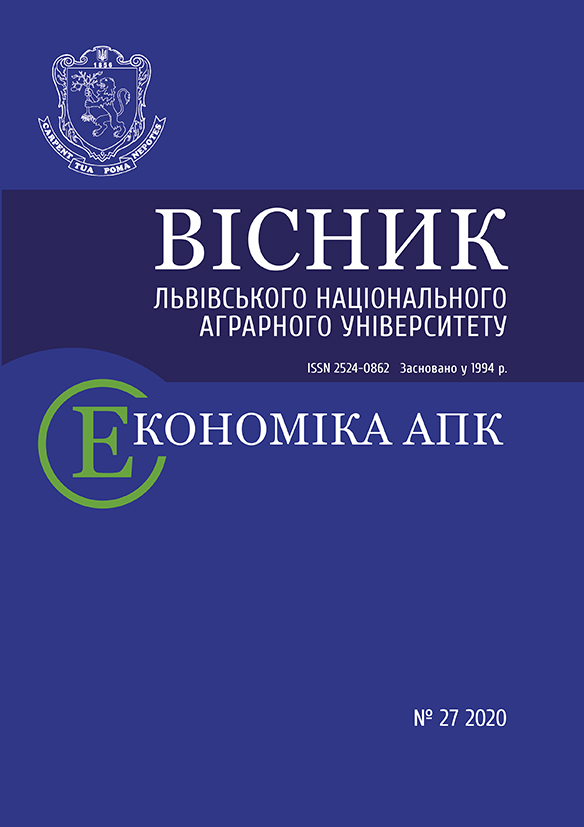Visnyk LNAU: Economics of AIC 2018 №25: 127-132
INSTITUTIONAL FRAMEWORK FOR PLANNING SUSTAINABLE USE OF AGRICULTURAL LANDS
Greshchuk G., Candidate of Economic Sciences
Bochko O., Candidate of Economic Sciences
Lviv National Agrarian University
https://doi.org/10.31734/economics2018.25.127
Annotation
The article identifies the concept of «traditional local product» and sets out the criteria that such products should meet. The main obstacles preventing small producers, who produce traditional local products, from obtaining higher profits are highlighted. On the example of Yas beans the process of adding value to a traditional local product is illustrated. The variety “Yas bean” and requirements for its cultivation and storage are described in detail. The historical binding to the western territories of Ukraine as a zone of traditional cultivation of this variety is noted. The costs and expected returns for small Yas bean growers are calculated on condition of membership in the cooperative and sale the packaged finished product. The experience of the agricultural service cooperative «Stryysky Yas» for the production of Yas bean, its calibration, packaging and sale is described. A wide range of options to create adding value to Yas beans is given. The features of the French approach to the promotion of the product and the promotion of the area of its production are revealed. The role of gastronomic festivals and the experience of holding the first gastronomic bean festival «Stryysky Yas» are highlighted. The use of social networks as a tool for promoting the product and its production area is described. The main tasks for the agricultural service cooperative of bean growers the «Stryysky Yas», which will allow it to be successful, provide higher profit for its members and positively influence the development of the production zone are determined. The benefits that the rural areas can receive when promoting a local traditional product and creating added value for it are given.The article describes modern features of the interaction of reproduction and protection of land resources, as three types of activities that should function in close interconnection. Historical analysis of various formulations by scientists of fundamental laws of development of agricultural production and its placement on the basis of optimization of various factors of agricultural production is carried out. The thoughts and ideas of scientists are analyzed, and one of the first to study the use of agricultural areas.
The analysis of the concept of the State Target Program for the Development of Land Relations in Ukraine for the period until 2020 helped to identify the lack of measures that would fully take into account and could radically improve the situation in the land sector and resist the development of land degradation. The main drawback of the program is the lack of a systematic approach to solving the problem of ensuring a complete and objective accounting of the quantitative and qualitative characteristics of all lands in accordance with their classification, establishing the boundaries of all land plots of various forms of ownership.
The main socio-economic processes that were established during the years of Ukraine's independence were identified and listed. These processes are the reason for the emergence of a whole range of new economic, social and environmental problems that have affected land relations, necessitating the formation of a state land policy in the context of regional development. Therefore, in order to overcome these problems, the institutional priorities of the conceptual provisions for planning the rational use of agricultural land and their protection have been revised, which will make it possible to establish a balance between the authorized authorities and the subjects of land use. Institutional priorities for the planning of sustainable use and protection of agricultural land are grouped according to the essential nature and roses assigned to them: ecological, economic, social, legal. It was established that the development of conceptual provisions for planning the rational use and protection of agricultural land should be based on a systematic approach to the problem of rational use and protection of agricultural land, providing for the establishment of interrelated targets based on the main objective, planning the use and protection of land.
Key words
agricultural land, institutional planning framework, land protection, land reproduction, sustainable land use.
Link
- Khvesyk M. A., Bystriakov I. K., Levkovska L. V., Pylypiv V. V. Sustainable development: worldview ideology of the future: [monograph]. Kyiv: Institute of Environmental Economics and Sustainable Development of the National Academy of Sciences of Ukraine, 2012. 465 p.
- Tretiak A. M., Dorosh Y. M., Dorosh O. S., Stetsiuk M. P. Development of land relations and the system of land management in Ukraine: monograph. Kyiv, 2011. 256 p.
- Tretiak A. M., Druhak V. M., Hunko L. A. Land survey projecting: organization of the territory of agricultural enterprises by means of ecological and territorial land organization. Kherson: OLDI-PLUS, 2014. 235 p.
- About approval of the Concept of the State Target program of land relations development in Ukraine for the period until 2020: Resolution of the CM of Ukraine № 743-р of June 17, 2009. URL: http://zakon0.rada.gov.ua/laws/show/743-2009-%D1%80 (Last accessed: 12.06.2018).
- Martyn A. H., Shevchenko O. V. Land organization of rural territories as a precondition for agro-landscape protection. Sustainable nature management. 2014. N 2. P. 102–106.
- Blaug M. 100 Great Economists Before Keynes. Moscow, 2005. 704 p.



